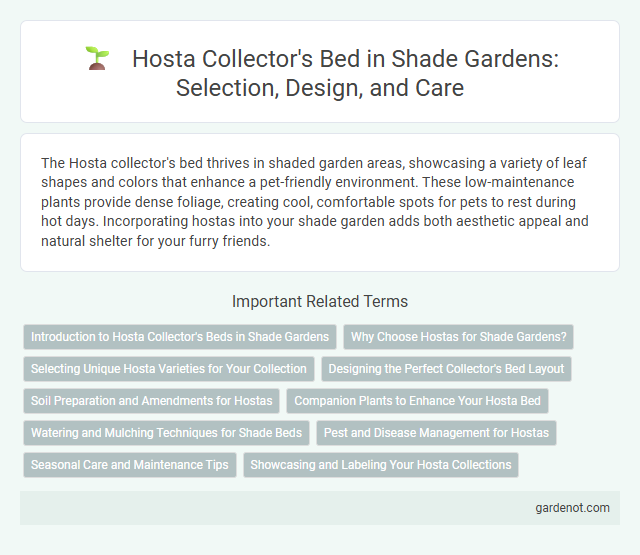The Hosta collector's bed thrives in shaded garden areas, showcasing a variety of leaf shapes and colors that enhance a pet-friendly environment. These low-maintenance plants provide dense foliage, creating cool, comfortable spots for pets to rest during hot days. Incorporating hostas into your shade garden adds both aesthetic appeal and natural shelter for your furry friends.
Introduction to Hosta Collector's Beds in Shade Gardens
Hosta collector's beds are specialized shade garden areas designed to showcase a diverse variety of hosta species and cultivars, emphasizing unique leaf shapes, sizes, and colors. These beds thrive in low-light environments, making them ideal for under-tree plantings where moisture and soil conditions are cool and well-drained. Cultivating hosta collections in shaded areas enhances visual interest through layered foliage textures and promotes biodiversity within the garden ecosystem.
Why Choose Hostas for Shade Gardens?
Hostas thrive in shade gardens due to their exceptional tolerance for low light conditions and their ability to maintain vibrant foliage color throughout the growing season. Their diverse leaf shapes, sizes, and textures create dynamic visual interest, while their low maintenance requirements make them ideal for shady areas where other plants struggle. Choosing hostas ensures reliable ground cover, moisture retention, and natural pest resistance in shaded environments.
Selecting Unique Hosta Varieties for Your Collection
Choosing unique Hosta varieties for your shade garden enhances both texture and color diversity, with options like Hosta 'Guacamole' offering vibrant chartreuse leaves and Hosta 'Blue Mouse Ears' providing compact, blue-gray foliage. Incorporating rare cultivars such as Hosta 'Empress Wu' introduces large, striking leaves that stand out in any collection. Prioritize disease-resistant and slow-spreading varieties to maintain a healthy, manageable Hosta collector's bed.
Designing the Perfect Collector's Bed Layout
When designing the perfect Hosta collector's bed layout, prioritize grouping varieties by contrasting leaf shapes and colors to maximize visual interest in low-light conditions. Incorporate varying heights and textures to create depth, ensuring each Hosta receives adequate space for growth and airflow to prevent disease. Utilize rich, well-draining soil enriched with organic matter to support the diverse needs of different Hosta cultivars in the shade garden environment.
Soil Preparation and Amendments for Hostas
Rich, well-draining soil with high organic matter is essential for a thriving Hosta collector's bed, promoting healthy root development and vibrant foliage. Incorporate ample compost, aged leaf mold, or well-rotted manure to enhance moisture retention and nutrient availability. Maintaining a slightly acidic to neutral pH between 6.0 and 7.5 ensures optimal nutrient uptake for diverse Hosta varieties.
Companion Plants to Enhance Your Hosta Bed
Companion plants such as ferns, astilbes, and heucheras thrive alongside hostas, providing contrasting textures and complementary foliage colors that enhance the visual appeal of a shade garden. Incorporating spring-blooming bulbs like snowdrops or bluebells introduces seasonal interest before hostas fully emerge. Selecting companion plants with similar moisture and light requirements ensures a harmonious and healthy hosta collector's bed throughout the growing season.
Watering and Mulching Techniques for Shade Beds
Hosta collector's beds thrive with consistent moisture, requiring deep watering to maintain evenly moist soil without waterlogging. Applying a 2-3 inch layer of organic mulch such as shredded leaves or bark helps retain soil moisture, regulate temperature, and suppress weeds in shade garden environments. Proper mulching combined with targeted watering reduces stress on hostas and enhances their vibrant foliage in densely shaded areas.
Pest and Disease Management for Hostas
Effective pest and disease management in a Hosta collector's bed involves regular inspection for common threats like slugs, deer, and fungal infections such as anthracnose and crown rot. Utilizing organic slug baits, deer repellents, and improving air circulation through proper spacing reduces infestation risks. Prompt removal of affected foliage and maintaining dry soil conditions help prevent disease spread and promote healthy Hosta growth.
Seasonal Care and Maintenance Tips
Hosta collector's beds require careful seasonal care to promote healthy growth and vibrant foliage. In spring, remove winter debris and apply a slow-release, balanced fertilizer to support developing roots and leaves. During summer, provide consistent moisture and mulch to retain soil moisture while cutting back damaged leaves in late fall to prepare the bed for winter dormancy.
Showcasing and Labeling Your Hosta Collections
Showcasing your hosta collections in a dedicated bed highlights the diverse leaf shapes, colors, and textures that define this shade-loving perennial. Clearly labeling each variety with weather-resistant markers enhances the educational value and helps track growth patterns, bloom times, and disease resistance. Grouping hostas by size, color, or leaf variegation creates visual harmony and facilitates easier identification for both novice gardeners and collectors.
Hosta collector’s bed Infographic

 gardenot.com
gardenot.com